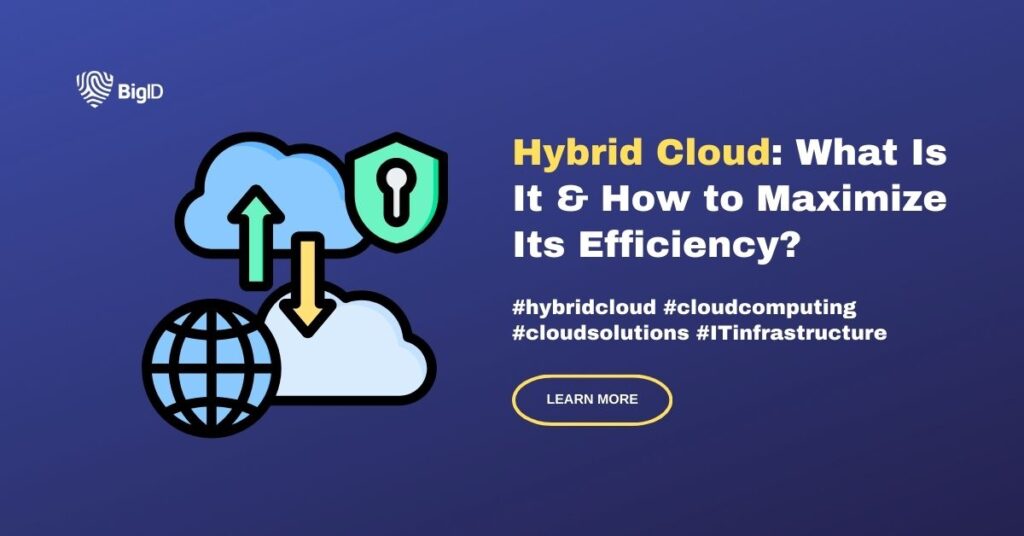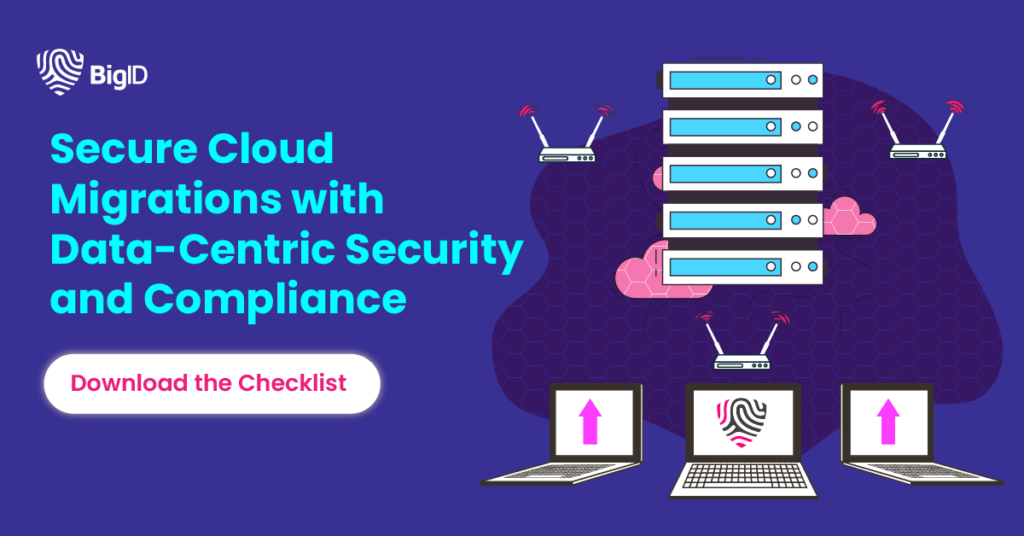More and more companies have been making a move to hybrid cloud environments as they look to balance the benefits of private and public cloud provider services. The global hybrid cloud market will reach $262 billion by 2025 from $85 billion in 2021.
But what’s behind this change? The general consensus is that it’s the need for better data management and security. By keeping sensitive data in a private cloud and using a public cloud solution for less sensitive workloads, organizations can maintain better control over their data and reduce the risk of security breaches.
Hybrid Cloud Definition and Architecture: How Hybrid Cloud Works
A hybrid cloud refers to a deployment where organizations use at least one public cloud service alongside their private cloud resources. By combining on-premises resources and public cloud infrastructure in this way, you can create a more cohesive computing environment.
What does this look like in practice? Essentially, some of an organization’s data and applications might be hosted in an on-premises cloud managed internally, while others are hosted by third-party cloud vendors, like Google Cloud, Microsoft Azure, or Amazon Web Services (AWS).
Additionally, some data and applications may be hosted on physical servers located on-premises while others are in data centers off-premises.
This combination of resources lets companies get the benefits of both the public cloud and on-premises data center. Public clouds give them cost-effective and on-demand access to computing resources that can be scaled, but they can also keep sensitive data in a private, more secure and easily controlled private cloud.
It’s a flexible, customizable computing infrastructure that can grow alongside the organization and meet a wide range of business needs.
Benefits of a Hybrid Cloud Infrastructure: The Best of Public Cloud and Private Cloud
Better Security
The hybrid approach lets businesses store their sensitive digital assets and software in a private cloud that is safer and easier to manage. This protects against security breaches, data loss, and other cyber threats.
Regulatory Compliance
Organizations have to remain compliant with industry-specific regulations and standards, such as HIPAA, the GDPR, and PCI-DSS in a secure and compliant private cloud while using public cloud data centers for non-sensitive data.
Customized Security Policies
With hybrid cloud platforms, businesses can change their security policies to align with the sensitivity of their data and workloads. This lets them put in place the right security measures, like encryption and two-factor authentication, to keep their applications and data safe.
Greater Control
Hybrid cloud infrastructure gives organizations greater control over their data and applications, allowing them to monitor and manage access, usage, and security policies.
Reduced Risk
Organizations can lower the risk of losing data and having services go down by using both private and public cloud services. If one cloud service malfunctions or fails, they can switch to another service or use resources on their own premises to keep things running.
Common Challenges of Hybrid Cloud Models
Data Privacy and Compliance
One of the biggest problems with hybrid clouds is making sure that data is private and that rules and standards that are specific to the industry are followed. To get around this problem, businesses should use a multi-layered security strategy that includes encryption, access controls, and regular security assessments and audits.
Identity and Access Management
Using a hybrid cloud can make it hard to manage user identities and access across many cloud and on-premises resources. To solve this problem, companies should set up a centralized identity and access management (IAM) system that lets all resources use the same authentication and authorization.
Cloud Service Provider Security
Public cloud resource providers may have different ways of keeping things safe than an organization’s private cloud or on-premises resources. To get around this problem, businesses should do a lot of research before choosing a cloud provider and put security controls in place to keep an eye on and manage the provider’s security practices.
Network Security
Effective network security management may be challenging due to the intricacy of a hybrid cloud. Organizations should use a network security architecture that covers both private and public cloud environments in order to overcome this difficulty and gain visibility and control over all network traffic.
Integration and Interoperability
Integrating and interoperating between different cloud and on-premises resources can be challenging, especially for security. To overcome this challenge, organizations should adopt a standard security framework, such as the Cloud Security Alliance (CSA) Cloud Controls Matrix, that can be applied uniformly across all resources.
Common Hybrid Cloud Best Practices: Hybrid Cloud Management Strategy
Set Clear Goals
The first step is to ask yourself: what are our business goals and objectives for adopting a hybrid cloud strategy? This ensures alignment with your organization’s overall IT and business strategy.
Assess Workloads
Once you’ve established your goals, it’s time to take a look at your current workloads and determine which are best suited for the public cloud, private cloud, or on-premises infrastructure. This should be based on factors like how sensitive the data is and compliance.
Implement Strong Security Measures
Always adopt robust security practices, including encryption, identity and access management (IAM), and regular security assessments to protect data across all environments.
Ensure Compliance
Stay compliant with relevant regulations such as GDPR, HIPAA, and PCI-DSS, using tools that help maintain compliance across hybrid environments.
Optimize Cost Management
Monitor and manage your cloud costs by taking advantage of tools that provide visibility into your spending, and allocate resources carefully to avoid unnecessary expenses.
Integrate Seamlessly
Make sure your on-premises systems and cloud work together smoothly. Use APIs and middleware to keep data flowing smoothly and apps communicate with each other.
Automate Processes
Let automation handle deployments, scaling, and everyday management. Orchestration tools can save time and cut down on manual work.
Prioritize Data Governance
Set clear rules for who can access data and how it’s stored, in order to keep it protected. Also, keep data handling consistent across all environments.
Maintain Performance and Availability
Monitor performance metrics and ensure high availability of applications. Use load balancing and disaster recovery strategies to minimize downtime.
Foster Collaboration
Encourage teamwork between IT and business teams. Offer training and support so everyone can get comfortable with new technologies.
Regularly Review and Update
Continuously review and update your hybrid cloud strategy to adapt to evolving business needs and technological advancements. Regularly assess performance and make necessary adjustments.
Use Hybrid Cloud Management Tools
Hybrid cloud management platforms can help you gain more control and visibility over your hybrid environment, helping you monitor your data and automate processes. They also support with managing security.
GDPR and the Hybrid Cloud
The General Data Protection Regulation (GDPR) is a set of data protection regulations that govern the collection, processing, and storage, and sharing of personal data within the European Union (EU). The GDPR applies to any organization that processes personal data of EU residents, regardless of where the organization is located.
In a hybrid cloud, organizations can process personal data in both public and private environments, as well as on-premises resources. This can make it challenging to maintain compliance with the GDPR, as it complicates the process of ensuring that personal data is processed securely in accordance with the law’s requirements.
To comply with the GDPR in a hybrid cloud environment, you can, and should, adopt a multi-layered security approach that includes encryption, access controls, and regular security assessments and audits. You should also implement data minimization techniques to reduce the amount of personal data processed and ensure that personal data is only transferred to third parties with appropriate security and privacy measures.
What’s more, it’s a good idea to conduct thorough due diligence when selecting a cloud solution provider, ensuring that they have appropriate GDPR compliance certifications and controls in place before starting the cloud migration process.
Lastly, implement clear data processing agreements with the provider to double check that personal data is processed only in accordance with GDPR requirements.
Choosing a Hybrid Cloud Solution
When evaluating hybrid cloud computing platforms, look for the following attributes:
Compatibility and Interoperability
Is it compatible with a variety of public and private cloud environments? Does it support interoperability between these environments? This feature allows organizations to easily move workloads between different cloud storages and manage resources from a centralized console.
Security and Compliance
Does it provide robust security and compliance features, including encryption, access controls, and compliance certifications for industry-specific regulations and standards? Organizations must ensure data and applications are protected and compliant with regulatory requirements.
Scalability and Flexibility
Can organizations easily add or remove resources as needed and adapt to changing business needs? Scalability and flexibility enable organizations to optimize resource utilization and reduce costs while maintaining performance and availability.
Integration With Existing Tools and Systems
Does it integrate with existing tools and systems, such as identity and access management (IAM) systems, network security tools, and automation and orchestration tools? This allows organizations to leverage existing investments and processes while maximizing the benefits of hybrid cloud technology.
Comprehensive Management and Monitoring Capabilities
Does it provide comprehensive management and monitoring capabilities, allowing organizations to monitor and manage resources across multiple cloud environments from a centralized console? This gives visibility into resource usage, performance, security, and tools for automation and orchestration.
Hybrid cloud products and services should provide organizations with a secure, scalable, and flexible environment while maintaining control over their data and applications. Organizations can achieve their business goals by selecting a platform that meets these attributes while minimizing risk and maximizing efficiency.
BigID’s Hybrid Cloud Approach
BigID is a data discovery and intelligence platform that helps organizations identify and manage sensitive data across their hybrid cloud environments. With BigID, organizations can gain visibility into their data assets, including personal data, and ensure compliance with data protection regulations such as GDPR and CCPA.
BigID can be deployed across multiple environments as well as traditional on-prem stores. This allows organizations to discover and classify sensitive data across their entire IT infrastructure, regardless of where it resides.
BigID uses advanced AI and next-gen machine learning algorithms to automatically and accurately scan, identify, and classify cloud data. This data-centric approach provides greater visibility and understanding of the organization’s cloud assets, making it easy to prioritize efforts to protect them.
BigID also provides tools to manage data access permissions, enforce data retention policies, and track data movement across the hybrid cloud.
To see how BigID can ensure compliance and improve your organization’s overall security posture in the cloud— schedule a 1:1 demo with our experts today.



